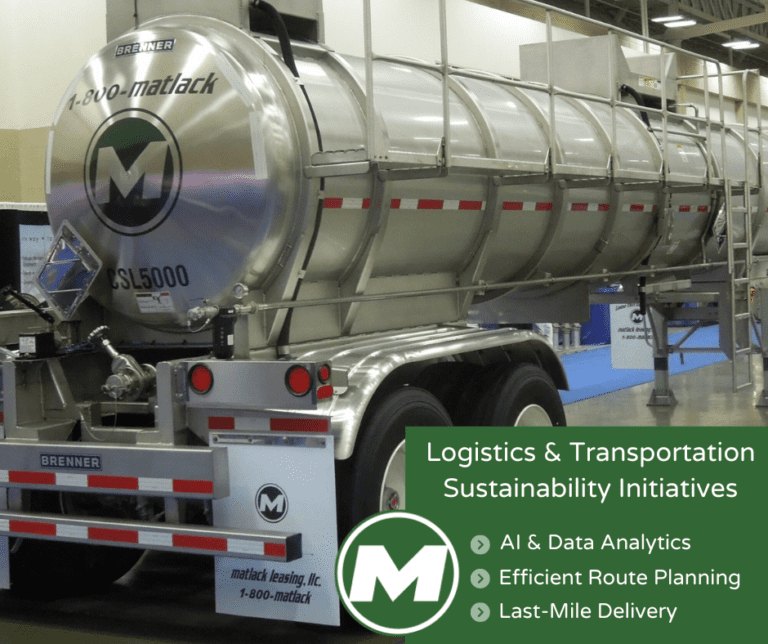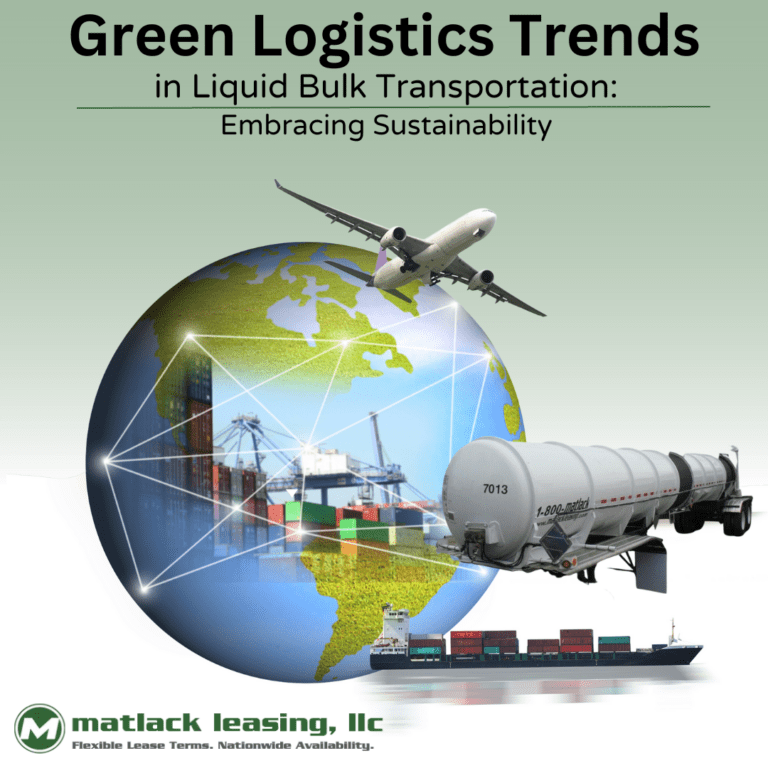Sustainability, commonly known as the ‘green’ movement, began in the 1980s, and since then has evolved into a global concern for the impacts people and businesses have on the environment. Businesses embracing these practices strike a balance between economic and environmental concerns. Often, sustainable practices reduce resource use and waste which in turn benefits the bottom line. Green logistics aims to improve efficiency and reduce environmental impacts in the transportation industry and, more specifically, in the supply chain, distribution and logistics sectors. Here we focus on the opportunities and challenges associated with the adoption of green logistics practices in the liquid bulk transportation sector.
Sustainability, defined by the Institute for Supply Management, is meeting present needs without compromising future generations. The transportation industry is embracing sustainability for operational efficiency and because of government requirements, consumer expectations, and to reduce risks to the environment. The primary objective is to maintain production and improve operational efficiencies while reducing waste which lowers the carbon footprint.
At Matlack Leasing, we specialize in leasing liquid bulk transportation trailers and chassis, Our tank trailers may be leased with options to meet client specifications such as tank liners, insulation, vapor recovery, and/or heating and cooling. Contact us today to learn about how our equipment performs in all kinds of roadway and weather conditions, and to learn about tank trailer options which are available to preserve product quality during transport.
Supply Chain Transparency
Supply chain transparency is a recent development propelled by growing consumer demand, particularly from younger generations who are starting families and entering the workforce. It refers to a company’s capacity to track and communicate the environmental impact of activities within the supplier and vendor network. A recent study conducted by the MIT Sloan School of Management concluded that consumers are willing to pay 2 – 10% more for products from businesses that provide supply chain transparency and demonstrate a commitment to social and environmental conservation. Businesses use strategies such as on-shoring and using near-by suppliers and vendors to minimize trip miles and shorten delivery times.
Circular Supply Chains
The concept of the circular supply chain is an extension of the sustainable supply chain movement that aims for zero waste. The goal of a circular supply chain is to eliminate landfilled waste by promoting the ongoing utilization of resources through repairs, reuse, recycling and minimizing the use of resources during production. Logistics strategies which employ these principles include the implementation of reverse logistics and load optimization. Asset management programs play a pivotal role in the movement toward circular supply chains. Liquid bulk transportation companies can lease equipment, such as tank trailers and tank chassis, which are returned, repaired, and used elsewhere when a market changes, representing an opportunity to move toward a circular supply chain.
Logistics and Blockchain Technology
A recent technology that is adding value by enabling greater transparency in supply chains is the incorporation of blockchain tracking. Blockchain technology was developed for the cryptocurrency industry as a digital record keeping system for digital assets. The same technology can be applied to supply chains to enable raw material source identification and provide quality assurance and traceability throughout product development. However, one challenge with blockchain technology is the vast amount of energy needed to power it. One must be careful where they source blockchain technology from and opt for renewable energy power sources to achieve the greatest benefits.
As you explore the evolving landscape of supply chain transparency, circular supply chains, and the potential incorporation of blockchain technology, it is crucial to tailor these advancements to your liquid bulk transportation needs. At Matlack Leasing, we specialize in tank container chassis and tank trailers, specifically designed to meet the demands of the liquid bulk transportation industry. Whether you’re involved in logistics, distribution, operations, or purchasing within chemical manufacturing and distribution facilities, our fleet, including DOT407s for food-grade liquids for chemical distribution and DOT412s for acids and corrosives, can be customized to your exact specifications.
Reach out to us today to discover how our innovative solutions can enhance the sustainability and transparency of your liquid transportation operations. Let’s shape the future of liquid logistics transportation together.
Sustainability in Logistics and Transportation
 The logistics and transportation industries are being influenced by sustainable and green practices. Consumer awareness of environmental impacts and the cost of transportation are driving the logistics and transportation industries to increase their efforts to make environmentally favorable decisions to reduce their carbon footprint. Fortunately for the logistics and transportation industries, advancements in operations have also proven to be beneficial to achieving sustainability goals.
The logistics and transportation industries are being influenced by sustainable and green practices. Consumer awareness of environmental impacts and the cost of transportation are driving the logistics and transportation industries to increase their efforts to make environmentally favorable decisions to reduce their carbon footprint. Fortunately for the logistics and transportation industries, advancements in operations have also proven to be beneficial to achieving sustainability goals.
AI & Data Analytics: Reducing Fuel Consumption & EmissionsThe integration of AI and data analytics is equipping the transportation and logistics industry with powerful tools to optimize fuel consumption and reduce emissions. Data processing and analyses can identify inefficient route patterns, facilitate fleet planning and offer valuable insights into preventative maintenance, real-time fuel usage, and emissions monitoring. Improving profitability while lowering environmental impacts. |
Efficient Route Planning and OptimizationRoute optimization software promotes environmental and sustainability goals by minimizing unnecessary miles. Applying this technology to transportation and routing enables an evaluation of the optimal route for deliveries lessening deadheading, designing route triangulation and optimizing backhaul (when appropriate). This logistics software is most effective when paired with other technologies such as advanced GPS systems. |
Last-Mile Delivery InnovationsThe need for “last-mile” delivery in the logistics industry is projected to steadily increase, including for tank trailers. These last-mile deliveries can be challenging from a sustainability perspective. While deadheading after transporting gasoline or corrosive chemicals is a sustainability concern, safety must be prioritized. Gains in sustainability may be had by creating efficiencies in routing and capacity increases. Larger recent model year trailers, like DOT407s and DOT412s, tend to be more efficient in these instances. |
Contact Matlack Leasing to learn how leasing recent model year equipment will contribute to your green logistics goals.

